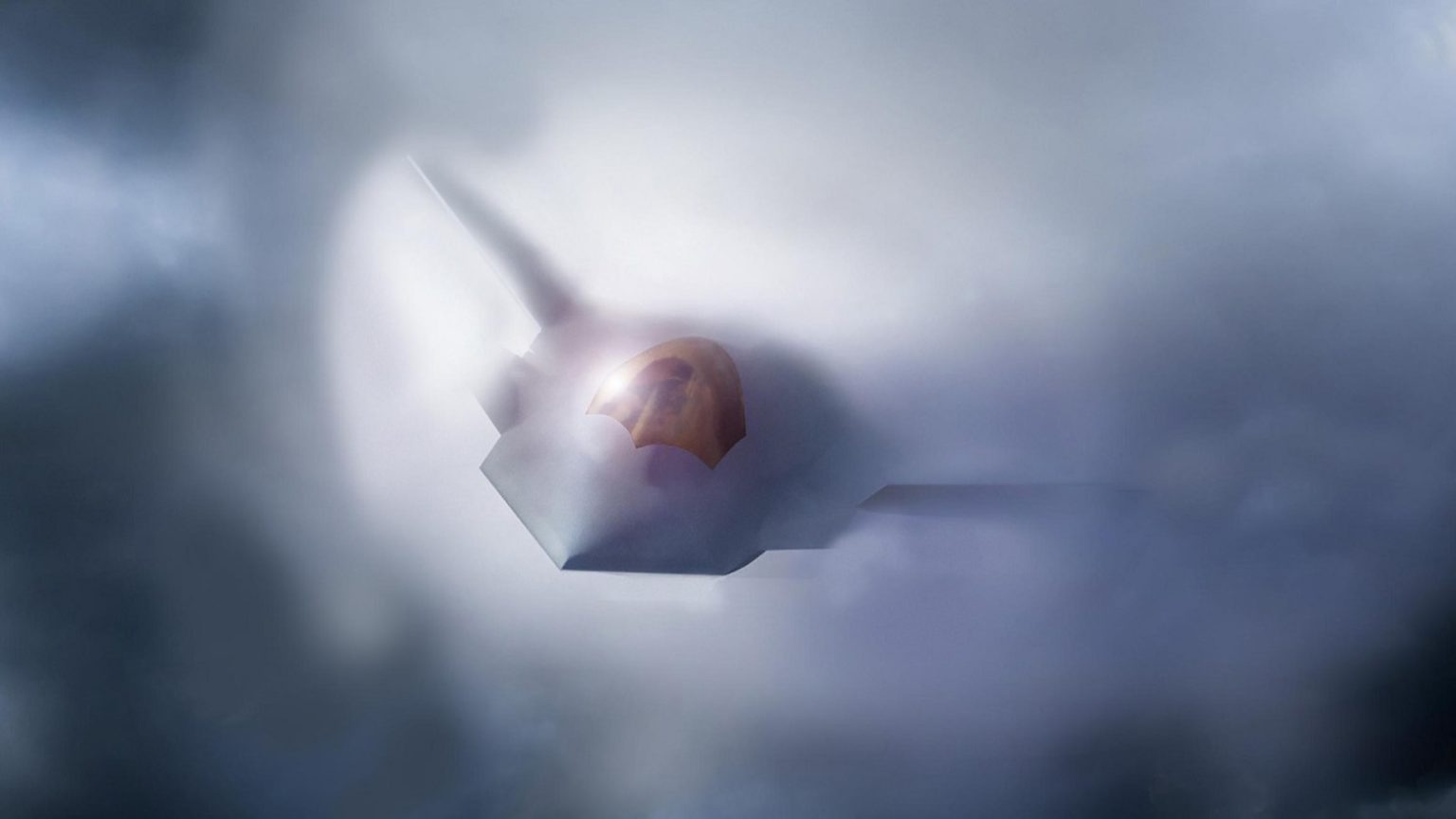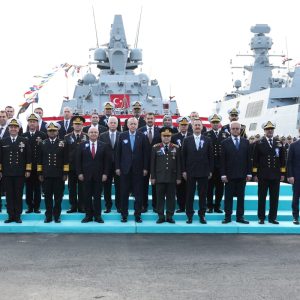Boeing’s F/A‑XX sixth‑generation fighter concept resurfaced with a new rendering showcased at Tailhook, stoking debate over how closely the Navy’s next carrier‑based jet will track the Air Force’s F‑47—and whether the U.S. industrial base can carry both programs in parallel. This analysis distils the design signals, programmatics and strategic stakes for carrier air wings in the Indo‑Pacific decade.
Key Facts
- Boeing released new imagery of its F/A‑XX, with cues that echo the Air Force’s F‑47 NGAD winner.
- Program dynamics: Pentagon’s FY26 posture prioritizes F‑47; Navy’s F/A‑XX receives limited funds for pre‑EMD work.
- Industrial base: White House flagged risk of two sixth‑gen fighters proceeding simultaneously; Boeing says it can execute both.
- Operational need: Navy leadership is eagerly awaiting a down‑select to preserve air superiority as legacy 4th‑gen numbers drop.
What the image signals—and what it doesn’t
The artwork shows a cloud‑shrouded aircraft above a carrier, with a canopy form and forebody proportions reminiscent of the Air Force’s F‑47 renders. Boeing’s composition again obscures the wingtips, canard junctions and the entire tail region—an intentional choice that keeps speculation alive about a tailless planform optimized for broadband stealth. For a Boeing F/A‑XX sixth‑generation fighter, canards—if present—would be tuned to carrier approach stability and low‑speed control, offsetting some of the penalties typically associated with radar signature growth at certain aspects.
Why the Navy’s requirements will diverge from F‑47
Despite surface similarities, navalization drives different trades than the Air Force’s deep‑strike profile. The F‑47 is sized around long‑range Pacific missions with an adaptive cycle engine (NGAP), >1,000‑nm combat radius and sprint regimes above Mach 2—paired with autonomous loyal wingmen. By contrast, the Boeing F/A‑XX sixth‑generation fighter is expected to emphasize range growth of ~25% over today’s F‑35C/Super Hornet, tanking efficiency, deck integration and endurance under salt‑fog conditions, likely with a derivative powerplant to simplify carrier logistics. Survivability in dense A2/AD will hinge on low‑observable shaping, electronic warfare, and resilient machine‑to‑machine networking with deck‑launched and carrier‑borne uncrewed systems.
Program reality check: budgets, timing, risk
In FY26 planning, the Pentagon banked on the Air Force’s F‑47 momentum while budgeting the Navy’s F/A‑XX for minimal pre‑design activity. The White House’s Statement of Administration Policy explicitly cautioned that awarding F/A‑XX as written could delay the higher‑priority F‑47, citing industrial base limits. Navy leaders counter that protracted delays would erode the carrier air wing’s qualitative edge just as 4th‑gen fleets retire and maintenance burdens rise. The signal to industry is mixed: proceed with risk‑reduction, but do not expect synchronized sixth‑gen production ramps.
Industrial posture: can Boeing really do both?
Boeing maintains it can prosecute the Air Force F‑47 while standing up Boeing F/A‑XX sixth‑generation fighter production if down‑selected. The company has committed roughly $1.8–$2.0 billion to expand classified assembly and post‑assembly capacity in St. Louis, while growing composite fabrication and systems test facilities across its Phantom Works footprint. Leadership changes also matter: Steve Parker—now confirmed as CEO of Boeing Defense, Space & Security—has publicly pushed back on the notion that the industrial base cannot support two parallel sixth‑gen efforts, arguing engine houses and tier‑1s can scale with phased ramps.
Competitive landscape: Boeing vs Northrop Grumman
Northrop Grumman has released its own F/A‑XX artwork—a sleek tailless concept with flowing radii that many observers compare to the YF‑23 lineage. Lockheed Martin, by most accounts, is no longer in the final round. With the Navy’s air boss eagerly awaiting a prime selection, both remaining bidders are using renders to signal design maturity without revealing sensitive edges. The optics also reinforce a strategic message: vendor competition remains intact even if the budget slows formal milestones.
Strategic stakes: carrier air wings in the Indo‑Pacific
For the Navy, a Boeing F/A‑XX sixth‑generation fighter is not a vanity project; it underwrites sea control. Long‑range anti‑ship weapons, counter‑air threats, and space‑enabled kill chains are compressing the carrier’s maneuver room. A 6th‑gen platform that pairs stealth, range, and human‑machine teaming would restore reach for stand‑in effects—and, crucially, hold adversary ISR‑strike networks at risk. As CNO leadership has argued, air superiority and sea control are inseparable; without the former, the latter becomes prohibitively costly.
Design watchpoints to track next
Planform & control surfaces: Will Boeing show trailing‑edge breaks or active flow devices that reconcile carrier handling with LO?
Propulsion path: Derivative engine now, with growth margin if adaptive cores migrate to the sea service later in the 2030s.
Mission systems: Sensor fusion and secure MUM‑T with carrier‑launched UAS, plus hardened navigation and LPI/LPD comms.
Sustainment: Corrosion‑resistant airframe treatments and modular bays to speed deck‑level swaps and sortie generation.
“If you have air superiority, then you have sea control. Those things go together… you need that fifth‑, sixth‑generation mix.”VADM Daniel Cheever, Commander, Naval Air Forces
Internal link
Related context on China’s pacing challenge and force‑design implications: PLA Air Force Modernization: What It Means for NATO Airpower.
External link
For a technical program snapshot of the F‑47 baseline underpinning these design cues, see the U.S. Air Force NGAD/F‑47 official release here.
References
- The Aviationist — “Boeing Unveils New F/A‑XX Rendering,” Aug. 30, 2025. Link
- Aviation Week — “New Boeing F/A‑XX Rendering Hints at Possible Similarities to F‑47,” Aug. 28, 2025. Link
- White House — Statement of Administration Policy (FY26 DoD), F/A‑XX industrial‑base concerns, July 2025 (PDF). Link
- DefenseScoop — “CNO nominee Adm. Caudle warns F/A‑XX delays…,” July 24, 2025. Link
- The War Zone — “F/A‑XX Next‑Generation Naval Fighter Selection Could Still Happen,” Aug. 25, 2025. Link
- AP News — “New top admiral takes over the US Navy…,” Aug. 26, 2025 (CNO Caudle). Link
- U.S. Air Force — “Air Force Awards Contract for NGAD Platform F‑47,” Mar. 21, 2025. Link
- U.S. Air Force Photo — NGAD/F‑47 rendering image details. Link
- Aviation Week — “Boeing Defense Leader Pushes Back on F/A‑XX Pause,” June 16, 2025. Link
- ENR — “Jacobs to Expand $1.8B Boeing Military Aviation Production Campus in St. Louis,” June 16, 2025. Link
- The War Zone — “Boeing’s New F/A‑XX Concept Looks Very Familiar,” Aug. 29, 2025. Link
- Reuters — “US Navy fighter competition ejects Lockheed…,” Mar. 4, 2025. Link











